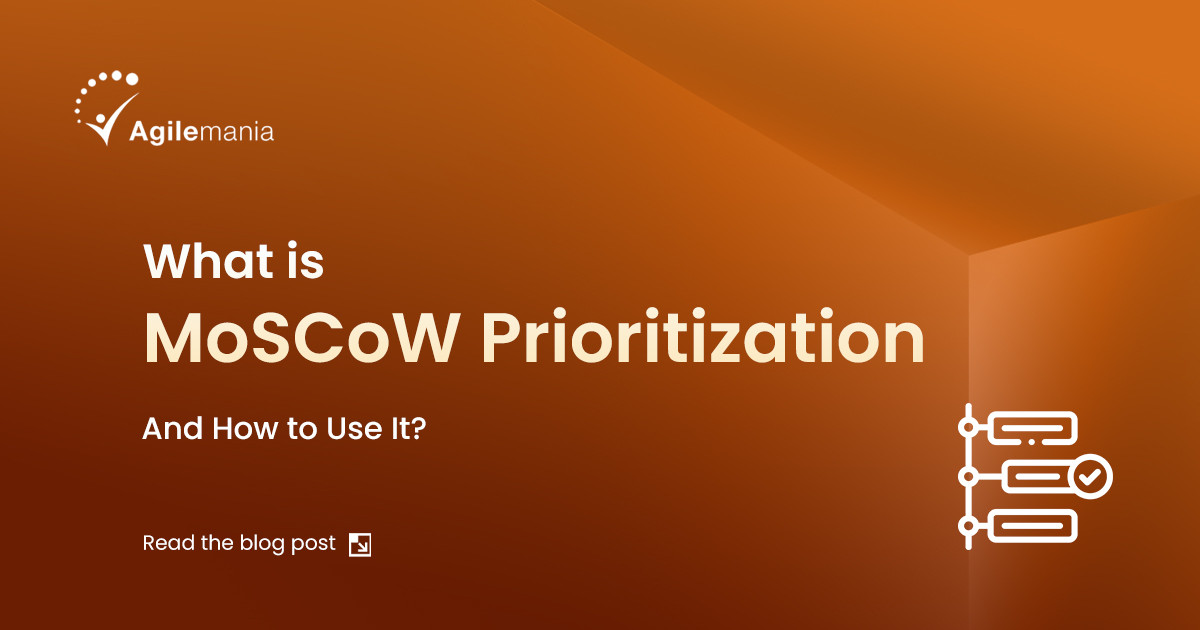
Agilemania
Agilemania, a small group of passionate Lean-Agile-DevOps consultants and trainers, is the most tru... Read more

Agilemania, a small group of passionate Lean-Agile-DevOps consultants and trainers, is the most tru... Read more

Ever feel like you're being pulled in a million directions at once? Managing priorities, juggling tasks, resources, and deadlines can be a constant struggle. This is especially true for project managers, product developers, and anyone who has to wear many hats.
There's a simple yet powerful technique that can help you achieve laser focus and make smarter decisions: MoSCoW prioritization. MoSCoW stands for Must Have, Should Have, Could Have, Won't Have, and provides a clear framework for categorizing your projects and tasks based on their importance.
In this blog post, we'll explore the benefits of MoSCoW prioritization and show you how to implement it to achieve greater clarity, improve communication, and ultimately, get more done.
MoSCoW (pronounced "Mos-Cow") is a simple yet powerful framework for prioritizing projects, tasks, or features. It stands for Must Have, Should Have, Could Have, Won't Have (this time), providing a clear structure to categorize them based on their criticality.
Developed by software guru Dai Clegg, MoSCoW helps teams achieve clarity and focus from the get-go. By establishing what's absolutely essential (Must Haves), what's desirable but not deal-breaking (Should Haves), and what can wait (Could Haves and Won't Haves), MoSCoW ensures everyone is on the same page and resources are allocated efficiently.
The MoSCoW prioritization framework goes by many names. You'll often hear it referred to as MoSCoW analysis, MoSCoW technique, or even MoSCoW rules.
The MoSCoW prioritization method is a valuable technique for project management that ensures alignment between stakeholders and the product team regarding objectives and prioritization factors.
Before diving into MoSCoW, some groundwork is essential. First, get key stakeholders and your team aligned on project goals and the factors that influence priority. This ensures everyone's on the same page from the outset.
Disagreements are inevitable. To prevent them from derailing your project, establish a clear process for resolving any conflicts that arise during prioritization. Will you use voting, seek input from a senior manager, or follow a predetermined set of criteria? Having a plan keeps the project moving smoothly.
Finally, decide how much effort (as a percentage) will be allocated to each MoSCoW category (Must Haves, Should Haves, etc.). This helps manage expectations and resource allocation. For example, will 80% of your resources focus on Must-Have features, leaving 20% for Should-Haves and Could-Haves?
Master project management with PMP® certification training. Comprehensive courses prepare you for the PMP exam, advancing your career and validating your expertise in project management.
Enroll Now
With the groundwork laid, let's explore the four categories that make MoSCoW tick:
As the name implies, Must-Haves are the absolute essentials, the non-negotiables without which your project simply fails. Focus on completing these first. Think of security features in a healthcare app – these are Must-Haves to ensure user data protection and regulatory compliance.
Here's a simple trick to identify Must-Haves: ask yourself, "If the product or release wouldn't work without this initiative, is it a Must-Have?" If the answer is yes, it belongs in this critical category.
Should-Haves are a step below Must-Haves in terms of criticality. They're important features that significantly enhance the value of your project or product, but they're not strictly mandatory. Think of performance improvements or minor bug fixes – while they don't make the product unusable, they certainly improve the user experience.
The key difference between Must-Haves and Should-Haves is flexibility. Should-Haves can often be deferred to a future release without derailing the current one. This allows you to focus on essential features first and then incorporate these valuable enhancements later.
Could-Haves are the desirable features that add a little extra something special – the sprinkles on your prioritization cupcake! They're not essential for core functionality, but they can elevate the user experience.
Compared to Should-Haves, Could-Haves have a much smaller impact if left out. Think of a new design element or a minor feature addition. While they'd be nice to have, they don't significantly hinder the product's core functionality.
One of the strengths of MoSCoW is the "Won't Have (This Time)" category. This allows you to manage expectations by clearly stating what will not be included in a specific release. Placing initiatives here prevents scope creep and ensures everyone's on the same page about what's being prioritized now and what can wait.
Some initiatives in "Won't Have" might be reconsidered for future releases, while others may be tabled indefinitely. Some teams even create subcategories within "Won't Have" to differentiate between these possibilities.
MoSCoW is a powerful tool that helps development teams prioritize tasks and features. Here's how development teams can leverage MoSCoW to tackle other prioritization:
What if deadlines are flexible, but your budget is tight? MoSCoW can help you and product managers decide which features are essential (Must-Haves) and which are desirable but not critical (Should-Haves). Then, with your limited budget in mind, you can figure out which Must-Haves can be delivered in this release. Should-Haves can be planned for future releases with more funding.
Even the most skilled team might not have everything covered. A product team might require features that need expertise they don't have. MoSCoW can help here too! During your MoSCoW analysis, consider your team's skill set when prioritizing features. Features requiring extensive development outside your team's expertise might be categorized as Could-Haves or Won't Haves (this time). This allows you to focus on what your team can deliver effectively.
Cross-functional teams often face pressure from different directions. Imagine wanting to push forward on a new product release, but senior management has tight deadlines for other projects. MoSCoW can help you navigate this situation. Use MoSCoW to determine which features of your desired release are absolute Must-Haves. Everything else can be temporarily backlogged. This allows you to meet critical deadlines while keeping future development plans on track.
By using MoSCoW's flexibility, development teams can overcome a wider range of prioritization challenges. This ensures they focus on what truly matters and deliver successful projects regardless of the limitations they face.
Project managers wear many hats – juggling deadlines, resources, and ever-changing priorities. The MoSCoW method can be your savior for handling these challenges and ensuring project success.
MoSCoW empowers you to prioritize tasks efficiently, even when faced with limitations. Managing cross-functional teams can be tricky, especially when juggling competing priorities from different departments. MoSCoW helps bridge this gap. When faced with a new product launch and tight deadlines from another project, use MoSCoW to identify the absolute essentials (Must-Haves) for your launch. This allows you to focus on meeting critical deadlines while keeping everyone on the same page.
Projects rarely go exactly according to plan. Unexpected roadblocks are inevitable. The beauty of MoSCoW is its flexibility. Even with the best planning, the MoSCoW categories allow you to adapt and prioritize effectively when challenges arise.
By using MoSCoW, project managers gain a powerful tool for navigating complex prioritization challenges, ensuring projects stay on track and deliver success, even when things get tough.
Let's imagine "MarvelMail," a company developing an email marketing software product. They're gearing up for a new release and need to prioritize features using MoSCoW.
Drag-and-drop email builder: This is the foundation for users to create visually appealing emails.
Email sending and scheduling: The core functionality of the software – users must be able to send emails and schedule them for future delivery.
Basic email analytics: Users need to track basic metrics like open rates and click-through rates to gauge campaign performance.
A/B testing capabilities: This allows users to test different versions of emails to optimize performance, but it's not essential for the initial launch.
Email personalization features: Adding personalized touches like subscriber names can improve engagement, but it can be offered in a later update.
Landing page creation tool: While valuable for comprehensive marketing campaigns, it's not crucial for basic email marketing needs.
Advanced segmentation features: Segmenting email lists allows for targeted campaigns, but it can be a later addition.
Multivariate testing: This allows for more complex testing than A/B testing, but it can wait for a future release with a focus on advanced users.
Social media integration: Posting email campaigns on social media can increase reach, but it's not a core functionality.
SMS marketing integration: This expands marketing reach beyond email, but it's outside the scope of the current release.
Advanced reporting and analytics: Highly detailed reporting can be a valuable add-on, but it can be offered as a premium feature later.
Customizable email templates: Pre-designed templates are sufficient for the initial launch, with custom templates as a potential future offering.
By applying MoSCoW, MarvelMail can ensure they focus on developing the essential features (Must-Haves) for a successful launch. They can then plan to incorporate the Should-Haves in future updates based on user feedback and market demands. The Could-Haves and Won't Haves become part of a longer-term product roadmap, ensuring a clear vision for future development without compromising on the initial release.
While there are no software tools specifically designed for creating MoSCoW templates, many project management and task management tools can be adapted to facilitate the MoSCoW prioritization process. Here are a few options:
Spreadsheets: Simple and readily available, spreadsheets like Google Sheets or Microsoft Excel allow you to create a basic MoSCoW template. You can list features or tasks in one column and assign them categories (Must-Have, Should-Have, Could-Have, Won't Have) in another.
Kanban boards: Tools like Trello, Asana, and Jira offer Kanban boards, which are visual representations of workflows. You can create separate lists for each MoSCoW category and drag and drop tasks between them as priorities shift.
Mind mapping software: Tools like Miro or XMind allow you to brainstorm features and visually organize them using a mind map. You can color-code or categorize branches of the mind map to represent MoSCoW priorities.
Project management software: Some project management platforms, like monday.com or Wrike, offer features like custom fields or tags that you can utilize for MoSCoW prioritization. Create a custom field or tag for priority and assign "Must-Have," "Should-Have," etc. to categorize tasks.
Remember, the most important aspect of MoSCoW is the prioritization process itself, not the specific tool you use. Choose a tool that fits your team's workflow and comfort level to ensure effective MoSCoW implementation.
Prioritizing tasks, features, and projects is a constant challenge for teams in today's fast-paced business environment. Without a clear framework, it's all too easy to lose focus, miss deadlines, and deliver products that fail to meet customer needs.
The MoSCoW prioritization method provides a simple yet powerful solution to this problem. By categorizing initiatives as Must Haves, Should Haves, Could Haves, and Won't Haves, teams gain clarity on what is truly essential, what is desirable, and what can be deferred or omitted entirely.
While MoSCoW is not without its limitations, following best practices such as involving key stakeholders, establishing objective criteria, and maintaining a customer-centric perspective can help teams overcome potential pitfalls and reap the full benefits of this powerful prioritization technique.
The MoSCoW method is a technique used in project management and product development to prioritize tasks, features, or requirements into these four categories based on their importance or criticality to the project's overall success.
Yes, MoSCoW prioritization is an effective method for streamlining project tasks and features. Its simplicity allows even newcomers to participate, fostering better team understanding of the project scope. MoSCoW's clear framework (Must-Haves, Should-Haves, etc.) helps evaluate tasks and make informed decisions about what to include in the project.
MoSCoW prioritization is important because it brings clarity and focus to product development. It helps you:
Set a timeline: By identifying Must-Haves first, everyone knows what needs to be completed for the initial launch.
Manage expectations: Stakeholders understand core functionalities and potential costs.
Maintain product vision: MoSCoW keeps the team focused on essential features, avoiding feature creep during development.
The MoSCoW method categories are:
Must Haves
Should Haves
Could Haves
Won't Haves (this time)
Agilemania, a small group of passionate Lean-Agile-DevOps consultants and trainers, is the most trusted brand for digital transformations in South and South-East Asia.
WhatsApp Us

We will get back to you soon!
For a detailed enquiry, please write to us at connect@agilemania.com
We will get back to you soon!
For a detailed enquiry, please write to us at connect@agilemania.com

